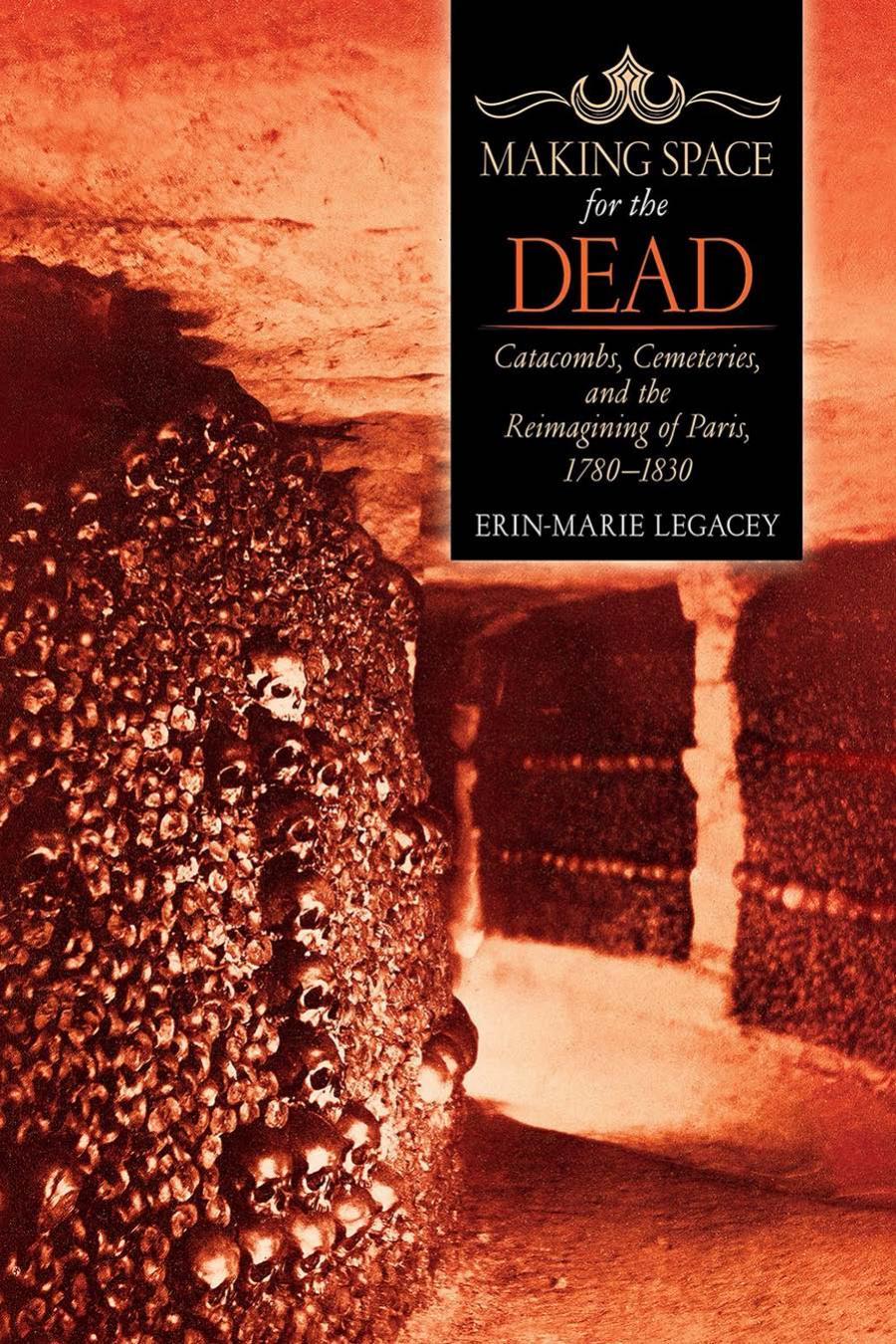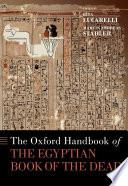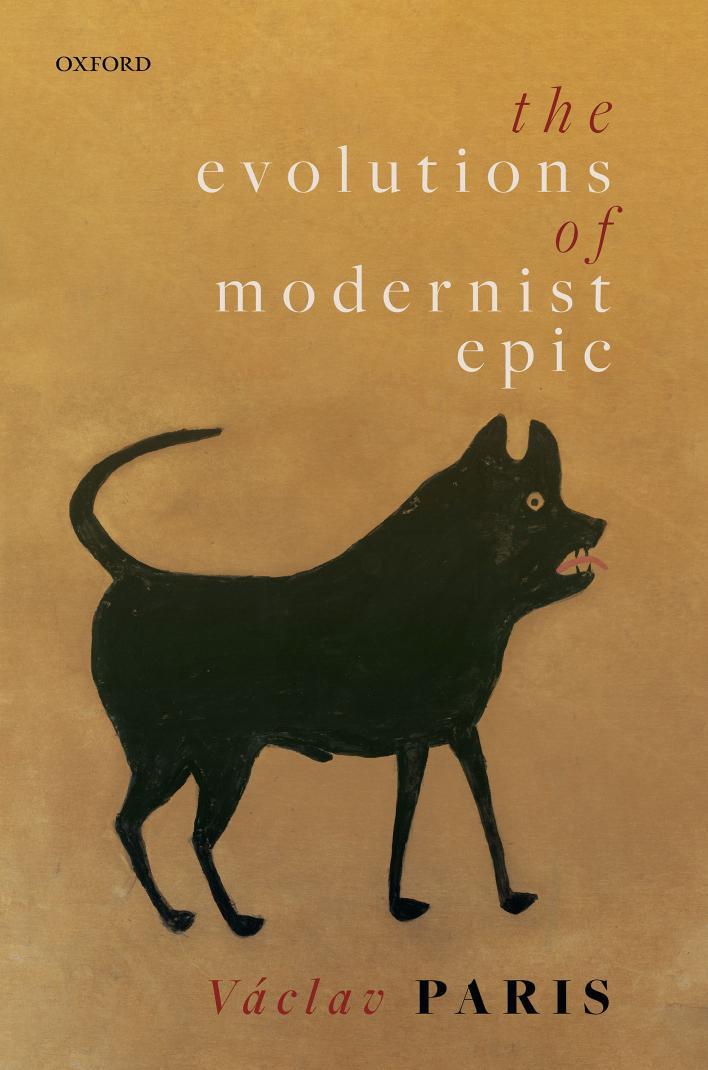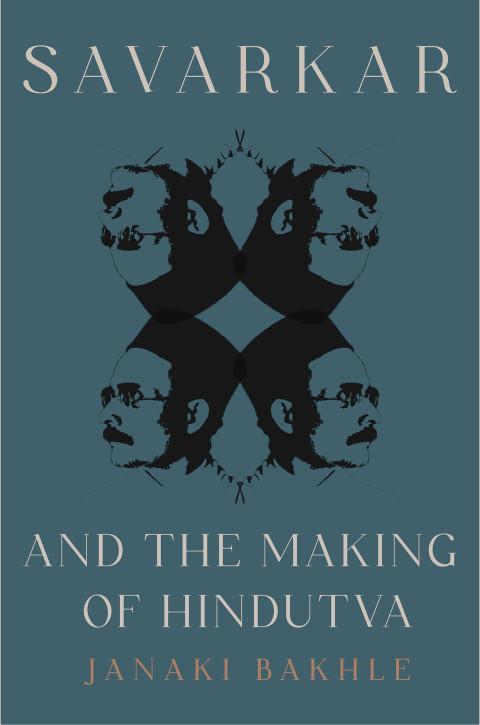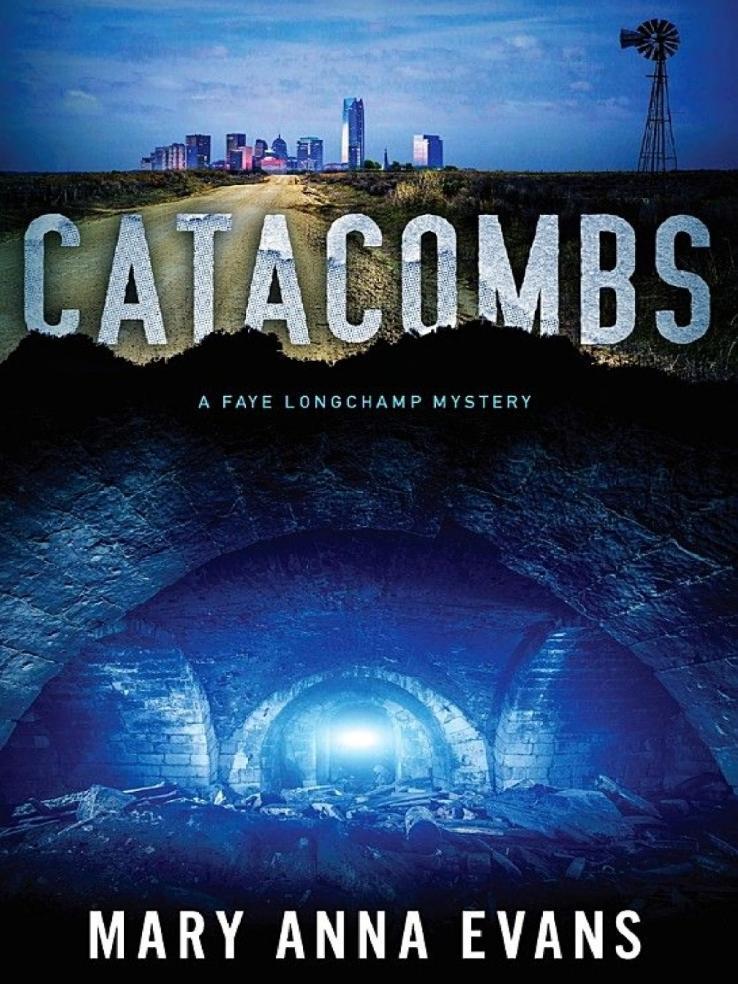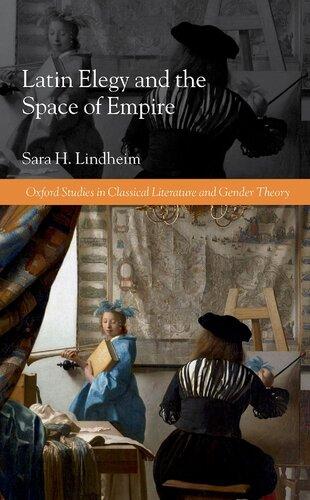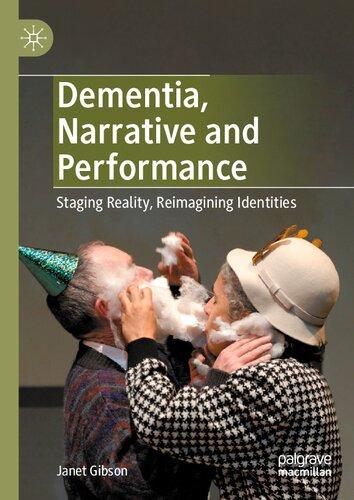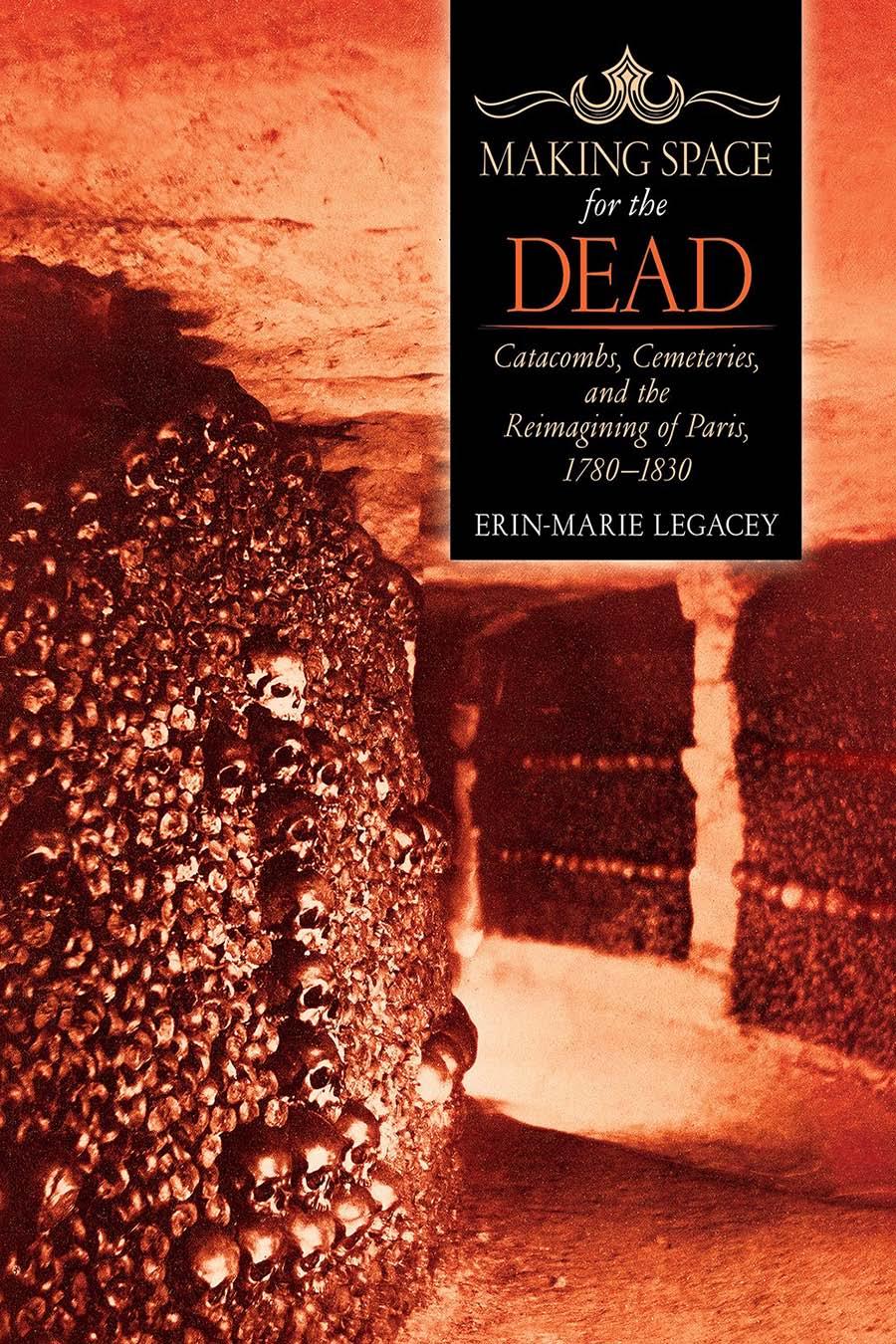Making Space for the Dead
Catacombs, Cemeteries, and the Reimagining of Paris, 1780–1830
Erin-Marie Legacey
Cornell University Press Ithaca and London
Copyright © 2019 by Cornell University
All rights reserved. Except for brief quotations in a review, this book, or parts thereof, must not be reproduced in any form without permission in writing from the publisher. For information, address Cornell University Press, Sage House, 512 East State Street, Ithaca, New York 14850. Visit our website at cornellpress.cornell.edu.
First published 2019 by Cornell University Press
Printed in the United States of America
Library of Congress Cataloging-in-Publication Data
Names: Legacey, Erin-Marie, 1979– author.
Title: Making space for the dead : catacombs, cemeteries, and the reimagining of Paris, 1780–1830 / Erin-Marie Legacey.
Description: Ithaca : Cornell University Press, 2019. | Includes bibliographical references and index.
Identifiers: LCCN 2018042962 (print) | LCCN 2018046294 (ebook) | ISBN 9781501715617 (pdf) | ISBN 9781501715600 (epub/mobi) | ISBN 9781501715594 | ISBN 9781501715594 (cloth : alk. paper)
Subjects: LCSH: Burial—Social aspects—France—Paris—History— 18th century. | Burial—Social aspects—France—Paris—History— 19th century. | Pere-Lachaise (Cemetery : Paris, France)—History. | Catacombs—France—Paris—History. | Paris (France)—Social life and customs—18th century. | Paris (France)—Social life and customs— 19th century. | France—History—Revolution, 1789–1799—Influence. Classification: LCC GT3249.P37 (ebook) | LCC GT3249.P37 L44 2019 (print) | DDC 393/.10944361—dc23
LC record available at https://lccn.loc.gov/2018042962
Cover illustration: View in the Catacombs, 1861. Albumen silver print by Nadar [Gaspard-Félix Tournachon]. The J. Paul Getty Museum, Los Angeles. Digital image courtesy of the Getty’s Open Content Program.
For my dad
List of Illustrations ix
Acknowledgments xi
List of Abbreviations xv
Introduction: The Revolution of the Dead 1
1. The Problem of the Dead 17
In which the French Revolution interrupts and intervenes in Paris’s preexisting burial crisis.
2. The Solution of the Dead 44
In which a range of experts and amateurs imagine a new burial culture for Paris after the Terror.
3. The City of the Dead 71
In which Parisians visit and respond to their city’s new burial space, Père Lachaise Cemetery.
4. The Empire of the Dead 99
In which thousands of visitors descend ninety feet below the city to tour the newly opened Paris Catacombs.
5. The Museum of the Dead 124
In which the artist and administrator Alexandre Lenoir displays the dead as history in the Museum of French Monuments.
Conclusion: The Historian of the Dead 153
In which the Romantic historian Jules Michelet resurrects the history of France in Parisian spaces for the dead.
1.1 The Cemetery of the Innocents in 1786 18
1.2 Mirabeau’s tomb in the Panthéon 26
1.3 The statue of death in the Cemetery of the Innocents 28
1.4 The remains of Henri IV, exhumed in 1793 34
2.1 Cross-section and design of Pierre Giraud’s Champ de repos 66
2.2 Perspective view of Pierre Giraud’s Champ de repos 67
3.1 Père Lachaise Cemetery in 1856 75
3.2 Tomb of Antoine Lagrange in Père Lachaise Cemetery 90
4.1 The final gallery of the Paris Catacombs in 1861 100
4.2 The monument to the September Massacres in the Paris Catacombs in 1861 108
4.3 Dramatic views of the Paris Catacombs in 1823 113
5.1 Alexandre Lenoir defending the royal tombs from destruction 130
Illustrations
5.2 The thirteenth-century room in the Museum of French Monuments 139
5.3 The remains of Louis VIII, exhumed in 1793 142
5.4 View of the Elysian Garden, seen from the tomb of Descartes 145
C.1 The tomb of Jules Michelet in Père Lachaise Cemetery 159
xii Acknowledgments
Harold Mah humored and honed my fascination with Jules Michelet— a strange nineteenth-century figure, whom I was delighted to resurrect for this book’s conclusion. I cannot overstate how grateful I am to Sarah Maza for her elegant mentorship, consistent encouragement, and shining example. I hope Sarah sees her smart and stylish influence reflected in these pages. I am also very thankful to Suzanne Desan for teaching me how to write with conviction and confidence about the French Revolution. Tessie Liu offered invaluable advice and insight on earlier versions of this project. I am beyond lucky to have had such an accomplished group of women in my corner.
Many colleagues have kindly shared their time, their ideas, and their example with me as I worked on this book. Abby Swingen, Aliza Wong, and Kelly Wisecup all offered valuable advice and suggestions for my initial proposal, which no doubt helped this book find a great home. My fellow Texas Tech historians in our Junior Faculty Writing Group helped me sharpen the introduction and chapter 1, and I am grateful for their help: Emily Skidmore, Sarah Keyes, Angela Diaz, Catherine Franklin, Katie Moore, Ben Poole, Jake Baum, Matt Johnson, Rick Lutjens, Patrick Scharfe, and Dale Kretz. Lubbock has been a surprisingly easy place to live and work, and I feel very lucky to be a part of such a collegial and supportive history department. I finished up this book in the twelve months after my second daughter was born, often with a baby in my arms or by my side. I am fortunate to have had the support and encouragement of my colleagues during this time. I am particularly thankful for Sean Cunningham, a department chair who understands and appreciates the importance of work-life balance. I am also grateful to Elizabeth Sharpe and the Gender Equity Council at Texas Tech for working to build a more supportive and inclusive university. In particular, I appreciate the Women Faculty Writing Program: I crafted this book’s introduction in the supportive silence of our weekly meetings.
I wrote the bulk of this book while in residence at the Newberry Library where I had the incredible good fortune of being the 2015–16 Andrew W. Mellon Foundation Fellow. While there, I was surrounded by a wonderfully interdisciplinary community of scholars. Our monthly fellows’ seminars were a source of pleasure as well as edification, and I know my work benefited immeasurably as a result of my participation in them. I would especially like to thank the other long-term fellows for creating
Acknowledgments xiii
such a supportive and stimulating intellectual environment: Susan Gaylard, Kelly Wisecup, Miriam Thaggert, Kara Johnson, Christen Mucher, Chelsea Blackmore, Suparna Roychoudhury, Cynthia Wall, Kat Lecky, and Bill Brooks. Brad Hunt was a dedicated and energetic vice president for research and academic programs, and I appreciated his leadership and guidance. I also extend special thanks to one of the Newberry’s scholarsin-residence, Christopher McKee, for his enthusiasm for my project and for generously offering to read drafts of chapters 3 and 4. It is perhaps a cliché, but my time at the Newberry was a genuinely transformative experience. Truly, there isn’t a week that passes where I don’t think fondly of my carrel on West Walton Street.
Friendships with smart and accomplished women have sustained me as I completed this book. In addition to those already mentioned, I want to thank Andreana Prichard, who has been by my side—in spirit, if not always in person—since the first day of graduate school. Julie Laut is a pillar of strength and wisdom who has taught me so much about balancing scholarship and motherhood. Emily Skidmore has been beyond generous with her advice since the day I met her and has set a sterling example that I strive to follow. I am also grateful for the online community of academic mothers (particularly those with babies born in 2017), whose advice, encouragement, good humor, strength, and honesty have been a daily source of inspiration and joy for me as this project neared completion.
Several organizations provided financial support for this book at various stages of its development. The Social Sciences and Humanities Council of Canada and the Graduate School at Northwestern University funded the initial research. As the project progressed and evolved, the History Department at Texas Tech University facilitated and supported additional research trips to Paris. Generous support from the Newberry Library and the Andrew W. Mellon Foundation provided me with the time, space, and resources to finally sit down and write. The office of the vice president for research at Texas Tech also provided much-appreciated financial support during my year in Chicago. The Humanities Center at Texas Tech generously helped with the acquisition of images and their copyrights.
When I began writing this book, I hoped that it would one day be published by Cornell University Press. At every stage of the publication process Cornell has exceeded my expectations. It has been a genuine pleasure to work with my editor, Mahinder Kingra. His patience, advice,
xiv Acknowledgments
and transparency turned a potentially daunting publication process into a truly enjoyable experience. I am grateful for the anonymous reviewers who read my manuscript and urged me to make my often-too-subtle arguments bolder and more pronounced. The final product is undoubtedly much sharper and more cohesive as a result of their thoughtful feedback. Thanks also to my production editor, Karen M. Laun, and my copyeditor, Jack Rummel, for helping push this book over the finish line.
Finally, but most elementally, I would like to thank my family, which has transformed in so many ways since this project began. After being my most ardent champion for over two decades, my father, Jamie, died several weeks before I began my Ph.D. program. In retrospect, however, it seems clear that he continued to exert great influence over my life and scholarship. I was not equipped to mourn his loss, so I bought a copy of Philippe Ariès’s The Hour of Our Death, hoping to gain some historical perspective. Little did I know, it would launch me into more than a decade of my own research and writing. I hope that this book can serve in some small way as a memorial to his influence and example. My mother, Valerie, is one of the strongest women I have ever known: she and my brother, Brandon, have formed a solid bedrock of love and encouragement for my whole life. Thanks also to Joanie and Bob Poole for their unhesitating generosity and kindness.
My deepest gratitude is for Ben Poole, who supports and challenges me in the best of ways. His influence and ideas are laced throughout this book, because he has been with me on every step of this journey, from Evanston, to Paris, to Lubbock. I am truly fortunate to have such an informed and careful thinker by my side. Our two intrepid daughters, Maggie and Jane, inspire me every day with their bravery, love, and wild imaginations.
Abbreviations
AIF Archives de l’Institut de France
AN Archives Nationales de France
AP Archives de Paris
BHVP Bibliothèque Historique de la Ville de Paris
BNF Bibliothèque Nationale de France
MMF Annual Catalog of the Museum of French Monuments (1800–1821)
Making Space for the Dead
Invalides
Vaugirard Cemetery
Montmartre Cemetery
Errancis Cemetery
Madeleine Cemetery
Place de la Révolution
Louvre
Museum of French Monuments
Montparnasse Cemetery
Closed Cemeteries
Locations of the Revolutionary Guillotine New Spaces for the Dead
Cemetery of the Innocents
Hôtel de Ville
Panthéon
St. Catherine Cemetery
Catacombs
Père Lachaise Cemetery
St. Marguerite Cemetery
Bastille
Place du Trône Renversé
Picpus Cemetery
Spaces for the dead in Revolutionary Paris. Map prepared by Bill Nelson.
The Revolution of the Dead
In December 1785, the dead moved from Paris’s heart into what Victor Hugo would later call its intestines. Shadowy figures entered the city’s oldest and largest cemetery, the Cemetery of the Holy Innocents, and began to dig. Inhabitants of neighboring buildings watched—some from their windows, and some from the street—as these men, working by torchlight, began the lugubrious and unprecedented process of emptying this historic burial space of its sacred contents. These city workers spent the next year digging human remains out of the cemetery’s deep mass graves and collecting the millions of bones that had accumulated in charnel houses around its perimeter. They then systematically transported carts full of bones and human remains to an underground quarry on the city’s southern periphery—a newly designated municipal ossuary that would soon be better known as the Paris Catacombs.1
This radical relocation was the culmination of a long campaign to end urban burial in the French capital. More specifically, it was the consequence of a 1780 royal ordinance that declared the Cemetery of the
Innocents to be an intolerable and illegal threat to the city, owing to the stinking vapors that constantly seeped from its muddy enclosure and endangered the health and well-being of anyone living in the neighborhood. The famous eighteenth-century chronicler of Parisian urban life, Louis-Sébastien Mercier, characterized the cemetery as an “immanent” danger, whose “cadaverous miasmas threatened to poison the atmosphere” of Paris. He further alleged that wine, milk, and bouillon served in the vicinity of the cemetery soured within hours and warned that the “cadaverous humidity” that clung to the nearby walls had lethal effects. “Yes,” he explained, “to absentmindedly place one’s hand against a wall impregnated with this moisture was to expose oneself to the effects of venom.”2 In this ancient space the dead were, quite literally, deadly.
Thirty years later C.-P. Arnaud, an architect and illustrator, walked through the gates of Paris’s newest burial space, Père Lachaise Cemetery, and described it as unquestionably the most picturesque site in the capital. “This cemetery,” he raved, “is nothing like the terrible and terrifying cemeteries that we used to see.” Visitors to Père Lachaise had absolutely no need to fear exposure to any “putrid miasmas” or dangerous exhalations, he asserted. Instead, they could expect “a vast picturesque garden” filled with beautifully landscaped winding paths and alleyways. To further highlight the difference between Paris’s old and new cemeteries, Arnaud noted that in the spring months, the air in Père Lachaise smelled of violets, lilacs, honeysuckle, and other flowering shrubs. He concluded his description of the new cemetery by promising that a visit to Père Lachaise would offer “the most interesting spectacle for the sensitive traveler,” who would find, in the midst of tombs, “the most bucolic site” suitable for meditations on death, the beauty of nature, and other heady subjects.3 In the span of a generation, Parisian spaces for the dead had completely transformed—both in reality and in the popular imagination—from deadly sources of contagion to delightful urban destinations.
This revolution in attitudes and design was not limited to Père Lachaise. Throughout the late eighteenth and early nineteenth centuries, Parisians could visit a succession of new urban spaces that contained, displayed, and commemorated the dead in new and exciting ways. These included well-known attractions, such as the Panthéon and the Catacombs, but also lesser-known sites such as a short-lived museum that brazenly displayed the tombs of all France’s kings, from Dagobert to Louis XV. As the
nineteenth-century historian Jules Michelet described this space, known as the Museum of French Monuments: “One could finally see France as she was, in her development, from century to century, and from man to man, from tomb to tomb.”4 Early nineteenth-century visitors to the Catacombs similarly treated the macabre subterranean space as a source of knowledge about themselves and their city. After touring the Catacombs in 1812, Thomas Détruisard encouraged others to similarly enter the so-called “Empire of Death” and bravely contemplate the “naked bones” on display. “They are of your brothers,” he explained, “who yesterday knew life just as tomorrow, you will know death.”5 As comments like these demonstrate, Parisian spaces for the dead had undergone more than an aesthetic transformation since 1780. By the early nineteenth century, a new culture of the dead had developed in the city; one that reconciled Parisians to their burial sites as sources of collective identity rather than urban decay.
The backdrop of this transformation was, of course, the French Revolution. While revolutionaries inherited a burial crisis from the Old Regime—exemplified by the closing of the Cemetery of the Holy Innocents—they did significantly more than simply complete the work of their predecessors. Rather, revolutionary political culture irrevocably altered expectations about the role that the cemetery could (and should) play in the city of the future. This was the result of an unprecedentedly ambitious program to create a new France based on principles like justice, equality, liberty, and patriotic duty. In an about-face from earlier fears of contaminating urban cemeteries, revolutionary political culture elevated spaces and rituals associated with the dead. At its best, this manifested as Jacques-Louis David’s spectacular public funerals for the assassinated “martyrs,” Jean-Paul Marat and Louis-Michel le Peletier.6 At its most notorious, the political power of the dead played out on the guillotine and in the infamous atheist cemeteries of 1793 that announced death to be “an eternal sleep.” In each of these cases, radical revolutionary logic dictated that spaces for the dead were capable of doing considerably more than safely and securely containing human remains; they could also educate and improve the community of the living. As Jean-Baptiste Avril put it when pitching a proposal for comprehensive burial reform in 1794, a well-ordered cemetery culture would “sow the seeds of social and heroic virtues” among the population, ensure the happiness of future generations, and kindle the “sacred fire of patriotism” in all hearts.7
While many of the most controversial elements of revolutionary burial culture fell out of favor after the end of the Revolution’s most radical phase (the Terror) in 1794, the state’s underlying commitment persisted: to create new cemeteries that would safely contain the dead, while improving the social and moral character of the living. Indeed, this didacticism became even more pressing as the eighteenth century came to a close and legislators, moralists, and other interested individuals grew increasingly preoccupied with mitigating the social disorder that they considered inseparable from the cataclysm of revolution. In this anxious narrative, virtually everything that held Paris and Parisians together was in flux, including political tradition, a social hierarchy based on birth and privilege, and the authority and power of the Catholic Church. While constructing a new social and moral order seemed like an overwhelming task, establishing a coherent and well-ordered set of burial practices and spaces was comparatively straightforward. However, once they were actually built and open to the public in the first decade of the nineteenth century, Paris’s new burial sites became remarkably complex social spaces that defied simple or consistent interpretations: one person’s postmortem paradise could easily be another’s shameless display of decadence. This book untangles the many overlapping—and sometimes conflicting—ways that Parisians used their new spaces for the dead to reimagine their collective identity in the wake of the Revolution. This vision for a new order was highly variable: depending on the venue and its audience, the France on display could be rigidly hierarchical, starkly egalitarian, or staunchly meritocratic. Similarly, it might recognize individual accomplishments, emphasize the communion of friendship, or celebrate a shared past. What these have in common, of course, is that they all represent attempts and opportunities to reorganize and restore a social order that seemed in pieces after the Revolution. This book argues that spaces for the dead—when they were first imagined, later built, and eventually used—provided a safe place to reassemble these pieces. The dead provided the glue.
Making Space for the Dead
The narrative that unfolds over the next five chapters is about the dead, but of course all stories about the dead are really about the living.
The interdisciplinary field of Death Studies has developed and expanded a great deal over the last few decades, but for the most part, scholars accept the basic tenet that a people’s attitudes and practices related to the dead vividly illuminate their values, political structure, and social organization. An earlier generation of historians, such as Philippe Ariès and Michel Vovelle, demonstrated this phenomenon by focusing primarily on attitudes (mentalités) toward death. Despite drawing different conclusions (Vovelle was a Marxist and Ariès a self-proclaimed “anarchist of the right”) both of these scholars agreed that a significant change in attitudes and behaviors toward the dead occurred in the eighteenth century.8 They linked this transformation to bigger processes of modernization, including secularization, urbanization, and the rise of the middle-class family. Since the end of the twentieth century, however, historians such as Craig Koslofsky, Vanessa Harding, and most recently Thomas Laqueur have shifted the focus from attitudes to rituals, practices, and space.9 Moreover, instead of interpreting death culture as something that reflects broader shifts, these scholars emphasize the power of the dead and their ability to help the living bring about (and process) radical change, particularly during times of flux. As Thomas Laqueur dramatically states in his 2015 book The Work of the Dead, “The work of the dead is to make culture and set the boundaries of our mortality.”10 This was especially the case during the era of the French Revolution with its underlying project of wholesale reinvention. The experience of the French Revolution was instrumental in reshaping how Parisians considered the role of the dead in their city. Correspondingly, the dead offered revolutionaries opportunities to think through and experiment with the application of abstract values like equality, justice, and the radical presentism that accompanied the annihilation of the past. Many of the most iconic examples of revolutionary culture involve the display, discussion, or depiction of the dead. This is why Antoine de Baecque argued—somewhat provocatively—that by 1793 “the corpse” had become “the conceptual object that allow[ed] revolutionary politics to be thought out.”11 The dead became rallying points for a population in the midst of a revolution and looking to make sense of the changes taking place around them. An aristocrat was a frightening and nebulous bogeyman until he mounted the scaffold, when his destruction became a symbolic and purifying act, just as the blood of a “martyr” sanctified the revolutionary cause.12 Similarly, as Joseph Clarke has demonstrated,
the commemoration of the high-profile dead during the Revolution, whether through elaborate funeral processions or new civic spaces like the Panthéon, was a heavy handed (and ultimately unsuccessful) attempt to bind the population to the revolutionary state.13 In short, the dead became powerful public figures and symbols during the Revolution—a significant departure from their Enlightenment-era role as a danger and a nuisance. At a moment when eighteenth-century Europeans were already in the process of reshaping their culture of the dead, as exemplified by the closing of the Cemetery of the Innocents in 1780, the startling events of the Revolution exploded and redirected that process.
This new role of the dead in the city was matched by an ambition to build worthy new cemeteries. As Richard Etlin has detailed, imaginatively conceived burial sites dated back to the end of the Old Regime, when Enlightenment architects drew up plans for elaborate city cemeteries that were never built.14 The revolutionary spirit of reinvention breathed new life into this macabre civic project, which flourished again at the century’s end. As this book articulates, the new spaces that appeared in Paris in the first decade of the nineteenth century gave shape to a new burial culture that was both a product of, and a reaction against, the experience of revolution. However, this book challenges some basic assumptions about the relationship between the Revolution and modern French burial culture. Most significantly, it complicates the notion that French cemeteries developed as highly polarized sites that reflected the tumultuous politics of the Revolution and its aftermath. Recent works have argued that in such a volatile context, cemeteries and death rituals became places for revolutionary reinvention, royalist expiation, and liberal resistance.15 While a partisan tone certainly characterized the funerals and tombs of high-profile political and military figures, this divisiveness fades dramatically when we look beyond public spectacles of mourning and wellknown gravesites. When early tourists to Père Lachaise Cemetery spied on their fellow Parisians sobbing at tombstones, they cried along with them. Underground in the Catacombs, visitors strongly identified with the “bona fide debris” of their predecessors on display. And in the ornate chambers of Paris’s first history museum, disinterred tombs told the story of France’s past, while poets buried in the backyard created a timeless community of sensitive souls. These stories all belie a reading in which nineteenth-century Parisian cemeteries were primarily ideologically
charged sites that amplified the era’s fractious political culture. In these new spaces where millions of Parisians lay buried, the pitched ideological battles of postrevolutionary France often gave way to a more benign spirit of concord.
These traces of communion rather than conflict all expand and challenge what we know about the aftermath of the Revolution. Historians often separate this era in two, with Napoleon Bonaparte serving as the barrier dividing the “post-Terror” period of 1795–1799 from the early nineteenth-century “postrevolutionary” era. Different narratives dominate each of these discrete phases. Since the publication of Bronislaw Baczko’s Comment sortir de la Terreur in 1989, scholars of the Revolution have paid increased attention to the last five years of the eighteenth century as a time of great instability when French politics oscillated between left and right and the population sought to make sense of their recent violent past, whether through retributive violence, legal proceedings, or cathartic cultural practices.16 By contrast, historians focusing primarily on the early nineteenth century emphasize the “search for stability” that characterized Bonaparte’s project of domestic pacification and consolidation, which continued as the conciliatory union et oubli (unity and forgetting) of the Bourbon Restoration.17 The story of Paris’s new culture of the dead bridges these two periods and intertwines their dominant historical narratives. On one hand, it backdates the “search for stability” to 1795, when didactic proposals for burial reform really began to flourish, often as explicit solutions to the chaos and disorder that authors associated with the Revolution. On the other hand, it extends cathartic cultural practices well into the nineteenth century, when visitors to the Museum of French Monuments, the Catacombs, and Père Lachaise self-consciously reflected on the meaning and legacy of revolutionary violence.
In terms of its periodization, this book may feel elusive. It is at its core a book about reactions and responses to the French Revolution, but its chronology does not necessarily follow the “postrevolutionary” timeline. Moreover, although this book deals with three radically different political regimes, the rigid divisions between Revolution, Empire, and Restoration are much less significant than the common themes uniting this era, including social reorganization, cultural reinvention, and historical recalibration. This method of approaching the decades surrounding 1800 as a
kind of continuum complements the work of other scholars who similarly interpret this era as a fruitful—if fraught—time that ultimately gave rise to many key features of modern French politics, society, and culture, from the bureaucratic and administrative state, to the bogeyman of the “bourgeoisie,” to a distinctively nineteenth-century understanding of the self.18 Like Paris’s modern burial culture, the creation of all these institutions reveal a widespread desire for stable social spaces and categories in the wake of the Revolution.
But there were many paths to “stability” and many visions of what France could have been after the Revolution. The political side of this phenomenon is well known. In addition to the royalist, republican, and imperial programs, a diverse group of postrevolutionary intellectuals, administrators, and activists pitched myriad alternatives for France’s political future, from Noel “Gracchus” Babeuf’s communitarianism, to the liberalism associated with Germaine de Staël and Benjamin Constant, to the apocalyptic conservatism of Joseph de Maistre.19 However, the aftermath of the Revolution was not limited to political theory. A parallel set of ideas about how to restructure the social world also circulated during this time. What kind of hierarchy (if any) would govern the nineteenth century? What kinds of shared values would form a solid foundation of moeurs to replace Catholic tradition? And what would provide the necessary social glue to bind individuals to each other, their nation, and their turbulent history?
Reformed burial spaces, both as proposed ideals and actually existing sites, quickly emerged as fecund environments where competing visions for social (re)organization circulated from the 1790s through the end of the Restoration. For example, throughout the 1790s intellectuals debated whether new cemeteries ought to be organized to reflect the “natural equality” of all citizens, or to showcase the reality of social hierarchies, whether based on wealth, birth, virtue, or merit. In practice, new spaces for the dead did all of the above: with its rows on rows of indistinguishable skulls, the Catacombs exemplified equality in death, while the shortlived Museum of French Monuments flipped Old Regime hierarchies by converting previously sacred royal tombs into artistic and historical curiosities. By contrast, Père Lachaise Cemetery quickly developed into a microcosm of the nineteenth-century Parisian economic pecking order, with its menu of options for burial and commemoration, ranging from
The Revolution of the Dead 9
state-funded temporary burials for the indigent to permanent and lavishly adorned family mausoleums. However, within each of these new sites, visitors found that they had ample space for reinterpretation. Not everyone who toured the Catacombs “read” the bones in the same way, and the opulence of Père Lachaise offended more than a few commentators who railed against the pretensions of Paris’s middle-class upstarts. While such variability frustrates any attempt at sweeping generalizations about the meaning of these spaces, it may also be the key to understanding their power.
Making Space for the Dead
Theories of urban and social space underpin many of the claims in this book, although they only make brief appearances in the text itself. Taking as my starting point Henri Lefebvre’s famous assertion that “new social relationships call for new spaces, and vice versa,” I investigate the cemetery as a discrete “space” in the city.20 In doing so, I follow the lead of other scholars of this period who have demonstrated the different ways that Parisians understood and mapped their city after the Revolution. Throughout the first third of the nineteenth century, Parisians, especially in the middle class, displayed great interest in categorizing urban social space as a way of making sense of the postrevolutionary world. In her analysis of Parisian guidebooks before and after 1830, Victoria Thompson explained how early nineteenth-century descriptions of the city overemphasized the differences between (and homogeneity within) Parisian neighborhoods as a way of imagining the postrevolutionary city as a “stable and harmonious whole” in which clear social distinctions produced social stability.21 Similarly, Dominique Kalifa’s work on the Parisian bas-fonds demonstrates how the social imaginary of the dangerous criminal neighborhood, which relocated repeatedly throughout the nineteenth century, often “turned out to be an active force of cohesion and solidarity” in the modernizing city.22 The desire to create new city spaces specifically for foul smelling matter was an eighteenth- and nineteenth-century project that went to the heart of these issues. As Alain Corbin famously asserted, “It would be futile to analyze social tensions and conflicts without accounting for the different kinds of sensibilities that decisively influence them.”23 Clearly, new ways of imagining and
describing their city helped Parisians articulate and address anxieties related to social reorganization after the Revolution.
However, cemeteries are qualitatively different from other kinds of urban space. They occupy a uniquely intermediary zone, which Michel Ragon has referred to as “a sort of antechamber, between this world and the next, a place of passage.”24 As scholars like Victor Turner have long maintained, such liminality can be powerfully generative, particularly during times of radical transformation, when the possible outcome of that transformation is in flux.25 The decades after 1789 were nothing if not radically transformative; this book investigates both the general liminality of this time period and the spaces it produced. For this I turn to Foucault, who also offered a theory—albeit less developed than Turner’s—of liminality, specifically as it applies to space. His short essay, “Of Other Spaces,” outlined the creative potential of alternative spaces that exist outside of (or in between) normative spaces. Indeed, the nineteenth-century cemetery was one of Foucault’s most sustained examples of an “Other Space” (or heterotopia) that by the nineteenth century had become a kind of strange mirror of the regular city, where every living family had its dead analog.26 Since Foucault, philosophers and geographers have debated the radical nature of heterotopias, particularly when discussing postindustrial Western cities. However, when thinking about France at the turn of the nineteenth century—a period that Foucault explicitly addressed in his original essay—many of his initial observations hold up. Particularly relevant is Foucault’s assertion that heterotopias operate as “counter-sites capable of juxtaposing in a single real space, several sites that are in themselves incompatible.”27 This concept resonates particularly well with this book’s overarching argument about the competing models of social organization that circulated in spaces for the dead. It was no accident that sites like Père Lachaise and the Paris Catacombs ended up being so intellectually productive: owing to their liminality (in both a geographic and conceptual sense) and their profound Otherness, they were almost predisposed to inspire multiple versions of the city they served.
But the usefulness of heterotopian theory does not end there. Foucault’s claim that heterotopias “begin to function at full capacity when men arrive at a sort of absolute break with their traditional time” recalls another theme that runs throughout the book: that spaces for the dead repaired
a crucial link to the past that was severed by the “absolute break” of 1789.28 This book takes seriously the disorienting effect that the Revolution’s proclaimed rupture in time had on the population. The dislocation caused by the Revolution was not just social, political, and cultural; it was also temporal. The (brief) adoption of a new calendar that restarted time on September 22, 1792, and the (even briefer) decimal clock were only the most idiosyncratic manifestations of a broader revolutionary repudiation of France’s Catholic and royal past.29 Accordingly, the “search for stability” that characterized France after the Revolution included a widespread desire to both reimagine and reconnect with the past that revolutionaries had so violently rejected. Scholars have long commented on the development of a modern historical sensibility around the turn of the nineteenth century; Stephen Bann even identified an “intense desire for history” as one of the defining features of the Romantic era.30 The caesura of the French Revolution was central to this project, as Peter Fritzsche’s work on the melancholy and nostalgia of the early nineteenth century has shown.31 This book brings this widespread cultural phenomena into the graveyard by exploring the ways in which Parisians used spaces for the dead to make sense of an increasingly remote past.
Finally, it bears repeating that this is a story about Paris. Although many of the themes at work in this book characterize France as a whole during this time, it is explicitly a book about the capital. Between 1789 and 1795, Paris was the undisputed epicenter of the political and social Revolution, and after 1795 it was the site that administrators most ardently wanted to clean up and protect from further upheaval. Cemetery reform would eventually expand throughout the country (and far beyond), but it began in Paris and was influenced by Parisian events. Moreover, well before the eighteenth century, Paris had a special relationship with its burial spaces. As Vanessa Harding has noted in her comparative history of cemeteries in early modern Paris and London, the Cemetery of the Innocents had long been a symbol of civic identity, owing to the “sense of generations of Parisians buried there, [and] visibly present in the bones piled high in the attics of the surrounding charniers.”32 This was especially the case during times of strife, such as the wars of religion, when the cemetery (and who could be buried within its walls) became a powerful marker of Catholic identity. By the end of the eighteenth century, this identity no longer suited Paris, but the city’s new
